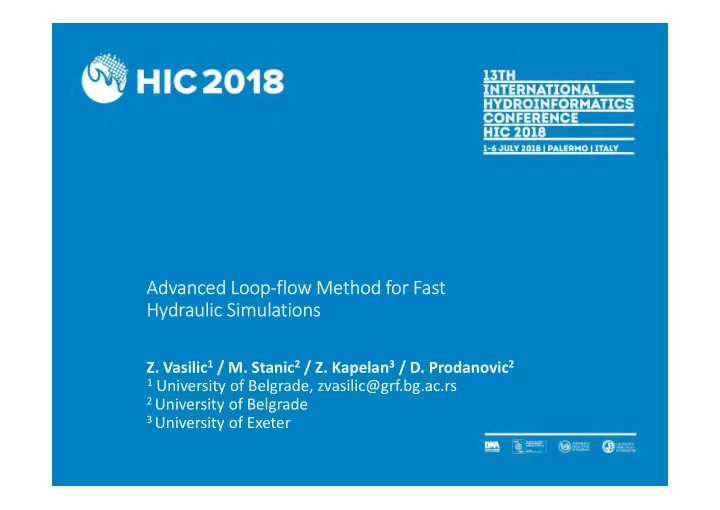

Advanced Loop-flow Method for Fast Hydraulic Simulations Z. Vasilic 1 / M. Stanic 2 / Z. Kapelan 3 / D. Prodanovic 2 1 University of Belgrade, zvasilic@grf.bg.ac.rs 2 University of Belgrade 3 University of Exeter
OUTLINE Introduction Methods for hydraulic analysis Overview of Loop-flow method Advanced Loop-flow method (TRIBAL-∆Q) Minimal basis loops identification alg. Efficient implementation of loop-flow method Examples, results & discussion Conclusions
INTRODUCTION Water Distribution Network (WDN) Purpose of Hydraulic simulation ? Essential prerequisite for any type of general WDN analysis is Mathematical model of the WDN Modification of the existing WDN Expansion of the existing WDN Multiple Optimisation process is usually involved Adopted scenarios/alternatives solution Need for the hydraulic simulation method Optimization Result efficient in terms of computational speed
METHODS for HYDRAULIC ANALYSIS Systematization of the methods Ref. Todini & Rossman 2013 Depending of the unknown variable: Q method GGA (EPANET) Node based equations H method ∆Q method (loop-flow) Loop based equations
METHODS for HYDRAULIC ANALYSIS Node vs. Loop based methods Node based Easy to „code“ (system of non-linear eqs.) Don’t require loop identification Loop based Less number of BWSN2 Network – Large unknowns (eqs) Network (Ostfeld et.al 2008): Solving branched 14 831 Links network is easier (No 12 523 Nodes iterative procedure) 2 308 Loops
Loop-flow ( ∆ Q) method Initial flows satisfy nodal continuity equations Loop head-loss equations are formed n 1 ( ) o ( ) o f Q , Q R Q Q Q Q ... 2 1 2 45 2 2 45 45 n 1 ( ) o ( ) o R Q Q Q Q ... 52 52 2 52 2 n 1 ( ) o ( ) o R Q Q Q Q Q Q ... 12 12 1 2 12 1 2 n 1 ( ) o ( ) o R Q Q Q Q 0 41 2 2 41 41 Non-linear system for the network n 1 T T T f ΔQ M R Q M ΔQ Q M ΔQ A H o o o o
Loop-flow ( ∆ Q) method Non-linear system for the n 1 T T T f ΔQ M R Q M ΔQ Q M ΔQ A H o o o o network NR Linearization of the -1 ΔQ = ΔQ - J f i 1 i i i system yields iterative solution form 4 loops X 4 links Structure of identified loops has great influence on solver’s efficiency 2 loops X 4 links 2 loops X 6 links
TRIBAL – ∆ Q method Combines: 1. New algortihm for optimal loop identification (TRIBAL) 2. Efficient implementation of loop-flow based hyd.solver ( ∆ Q) TRI angulation BA sed L oops (TRIBAL) identification algorithm is based on constrained Delaunay triangulation and Graph Theory
TRIBAL – ∆ Q method TRIBAL algorithm
TRIBAL – ∆ Q method TRIBAL – D Q method implementation
TRIBAL – ∆ Q method TRIBAL – D Q method implementation (1 st Block – Pre-processing)
TRIBAL – ∆ Q method TRIBAL – D Q method implementation (2 nd Block – Hyd. Simulation) ENRunLoops uses: linsolve routine to solve non-linear system newcoeff routine to calculate links coeffs Data from the 1 st Block 1 f 1 ij n 1 Q nR Q ij ij ij f f f n 1 ij 0 ij nR Q Q m J ( , ) m k ij ij k Q Q Q ij m k k k
TRIBAL – ∆ Q method TRIBAL – D Q method implementation (2 nd Block – Hyd. Simulation) newcoeff updates only links in loops
BENCHMARKING RESULTS 2 Case study networks PES BIN Network N n N l N s n RL n PL n L LF BIN 447 454 4 8 3 11 0.36 PES 71 98 3 28 2 30 0.96
BENCHMARKING RESULTS Comparison is made between 3 solvers: 1. GGA solver – as implemented in EPANET 2. TRIBAL – D Q solver 3. ASL – D Q solver Comparison criteria: t GGA ( ) 1. Computational efficiency (total time & speedup ) SPU F t ( Q ) 2. Convergence (num of iter) Reported calculation times are execution times for 2 nd Block Times are averaged over 10 series of 10,000 cumulative runs Target convergence for the discharge is eps=10 -3
BENCHMARKING RESULTS Convergence Computational efficiency BIN network BIN network 3.859 Number of Iterations 6 6 6 Simulation time (s) 1.111 1.087 GGA TRIBAL-DQ D Q ASL-DQ D Q GGA TRIBAL-DQ D Q ASL-DQ D Q
BENCHMARKING RESULTS Convergence Computational efficiency BIN network PES network BIN network PES network 7 7 3.859 Number of Iterations 6 6 6 Simulation time (s) 5 1.111 1.087 0.712 0.675 0.563 D Q GGA TRIBAL-DQ D Q ASL-DQ D Q GGA TRIBAL-DQ D Q ASL-DQ
BENCHMARKING RESULTS Efficiency of loop-based solvers compared to GGA BIN network PES network BIN network PES network NNZ elements in Cholesky factor 1035 3.551 3.475 2.14 % SPU F (-) 1.265 1.055 236 16.61 % 141 90 29 27 D Q D Q D Q D Q GGA TRIBAL-DQ ASL-DQ TRIBAL-DQ ASL-DQ
CONCLUSIONS New loop-flow based TRIBAL- D Q method is presented Computationally faster than GGA for steady state simulations Achieved speedups are result of: 1. Highly sparse solution matrix obtained with TRIBAL algorithm 2. Efficient implementation of D Q hydraulic solver Well suited for substantially branched networks Convenient for use in optimization tasks and networks with unchanged topology Accounting flow control devices and pressure-driven analysis
Advanced Loop-flow Method for Fast Hydraulic Simulations Z. Vasilic 1 / M. Stanic 2 / Z. Kapelan 3 / D. Prodanovic 2 1 University of Belgrade, zvasilic@grf.bg.ac.rs 2 University of Belgrade 3 University of Exeter
Recommend
More recommend